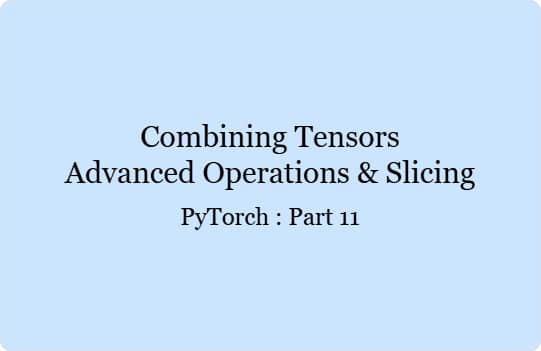Advanced indexing and slicing techniques in PyTorch allow for more sophisticated manipulation of tensor data. These operations are essential for efficiently handling and processing data in machine learning tasks.
Indexing with Tensors
You can use other tensors for indexing to extract or modify specific elements.
Indexing with Tensors:
import torch
tensor = torch.tensor([10, 20, 30, 40, 50])
indices = torch.tensor([0, 2, 4])
indexed_tensor = tensor[indices]
print(indexed_tensor) # Output: tensor([10, 30, 50])
Boolean Masking
Boolean masks can be used to filter elements based on a condition.
Boolean Masking:
tensor = torch.tensor([1, 2, 3, 4, 5])
mask = tensor > 3
filtered_tensor = tensor[mask]
print(filtered_tensor) # Output: tensor([4, 5])
Advanced Slicing with Steps
You can specify steps in slicing to extract elements at regular intervals.
Slicing with Steps:
tensor = torch.tensor([1, 2, 3, 4, 5, 6, 7, 8, 9, 10])
sliced_tensor = tensor[::2]
print(sliced_tensor) # Output: tensor([1, 3, 5, 7, 9])
Multi-dimensional Indexing
You can use advanced indexing techniques for multi-dimensional tensors.
Multi-dimensional Indexing:
matrix = torch.tensor([[1, 2, 3], [4, 5, 6], [7, 8, 9]])
rows = torch.tensor([0, 2])
cols = torch.tensor([1, 2])
indexed_matrix = matrix[rows, cols]
print(indexed_matrix) # Output: tensor([2, 9])
Example: Extracting Specific Features in a Batch
Advanced indexing and slicing are useful for extracting specific features or samples from a batch of data.
Extracting Specific Features:
batch = torch.randn(10, 5) # 10 samples, 5 features each
feature_indices = torch.tensor([1, 3])
selected_features = batch[:, feature_indices]
print(selected_features)
Extracting Specific Samples:
sample_indices = torch.tensor([0, 2, 4])
selected_samples = batch[sample_indices, :]
print(selected_samples)
Tensor Transposition and Permutation
Transposition and permutation are operations that reorder the dimensions of tensors. These operations are useful in various scenarios, such as preparing data for certain types of neural network layers or optimizing tensor operations.
Transposing Tensors
The transpose function swaps two specified dimensions of a tensor.
Transpose a 2D Tensor:
import torch
matrix = torch.tensor([[1, 2, 3], [4, 5, 6]])
transposed_matrix = matrix.transpose(0, 1)
print(transposed_matrix)
Transpose a 3D Tensor:
tensor_3d = torch.tensor([[[1, 2], [3, 4]], [[5, 6], [7, 8]]])
transposed_tensor_3d = tensor_3d.transpose(0, 1)
print(transposed_tensor_3d)
Permuting Tensors
The permute function rearranges the dimensions of a tensor in any specified order
Permute Dimensions of a 3D Tensor:
tensor = torch.randn(2, 3, 4)
permuted_tensor = tensor.permute(1, 0, 2)
print(permuted_tensor.shape) # Output: torch.Size([3, 2, 4])
Practical Example: Preparing Data for Convolutional Layers
In deep learning, particularly in convolutional neural networks (CNNs), data often needs to be transposed or permuted to match the expected input shape of different layers.
Transposing a Batch of Images:
# Batch of images with shape (batch_size, height, width, channels)
batch = torch.randn(10, 32, 32, 3)
# Transpose to (batch_size, channels, height, width)
transposed_batch = batch.permute(0, 3, 1, 2)
print(transposed_batch.shape) # Output: torch.Size([10, 3, 32, 32])
Example: Using Transposition in Neural Networks
Transposition can be useful for aligning data with the expected input shapes of different neural network layers.
Transposing in a Neural Network:
import torch.nn as nn
class TransposeNN(nn.Module):
def __init__(self):
super(TransposeNN, self).__init__()
self.conv1 = nn.Conv2d(3, 16, kernel_size=3, stride=1, padding=1)
self.fc1 = nn.Linear(16 * 32 * 32, 10)
def forward(self, x):
x = self.conv1(x)
x = x.view(x.size(0), -1) # Flatten the tensor
x = self.fc1(x)
return x
model = TransposeNN()
batch = torch.randn(10, 32, 32, 3)
transposed_batch = batch.permute(0, 3, 1, 2)
outputs = model(transposed_batch)
print(outputs.shape) # Output: torch.Size([10, 10])

